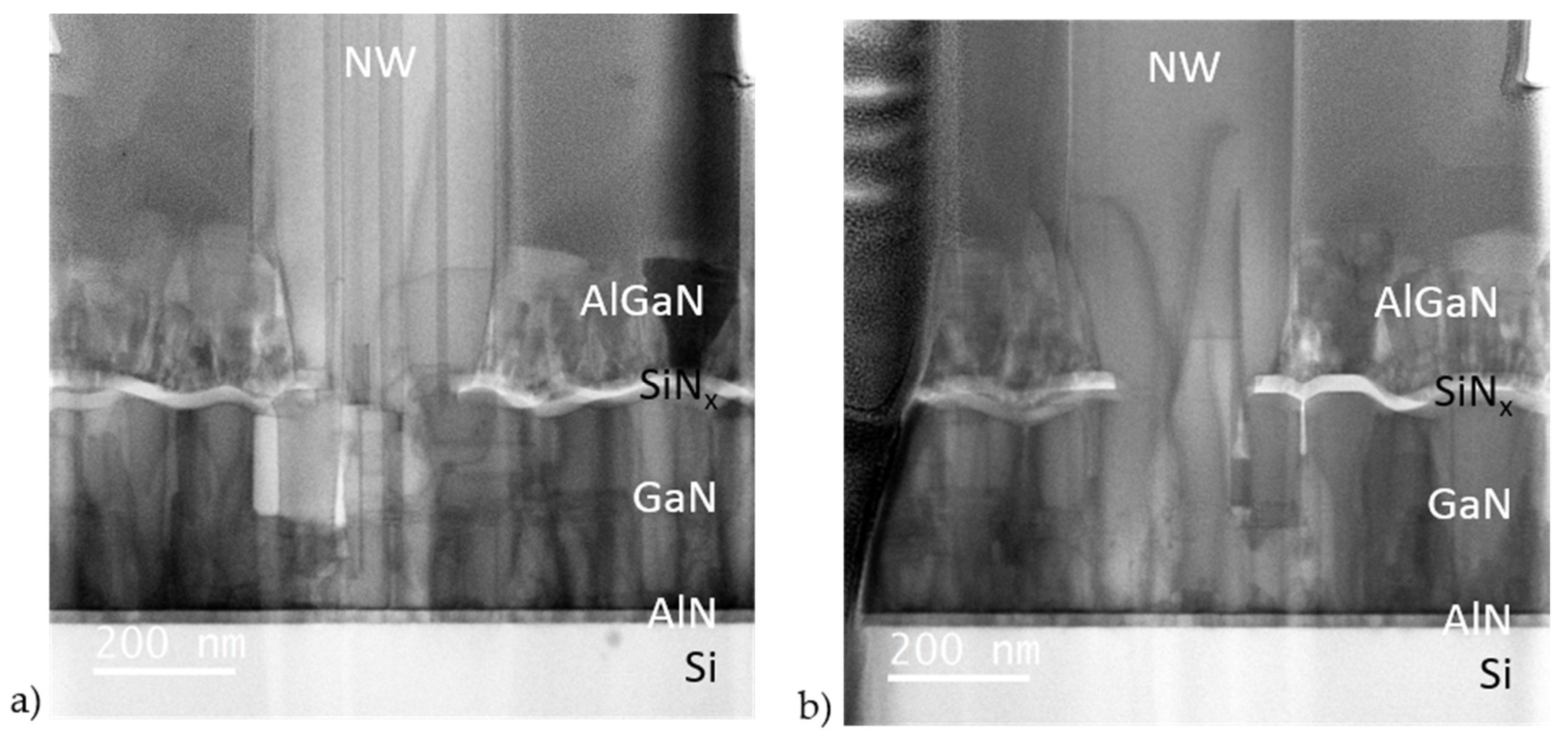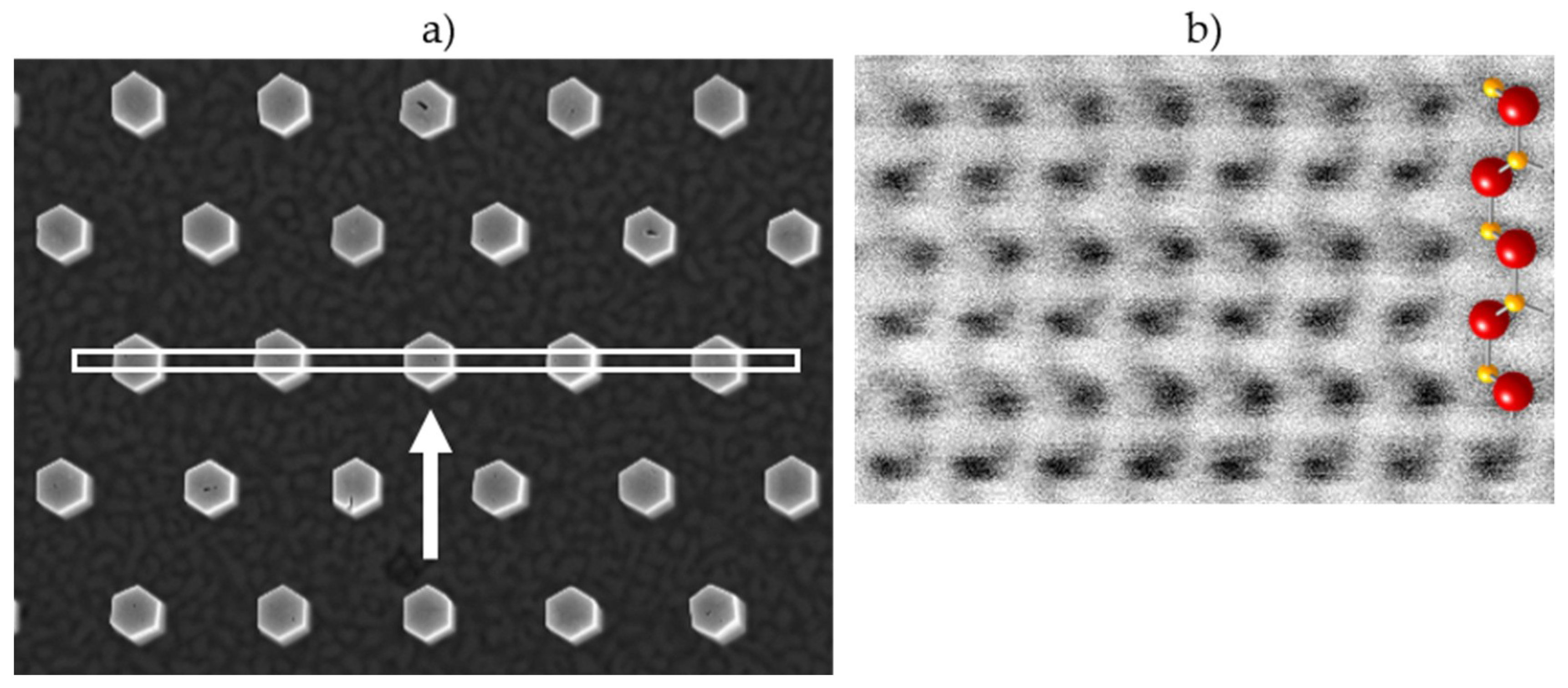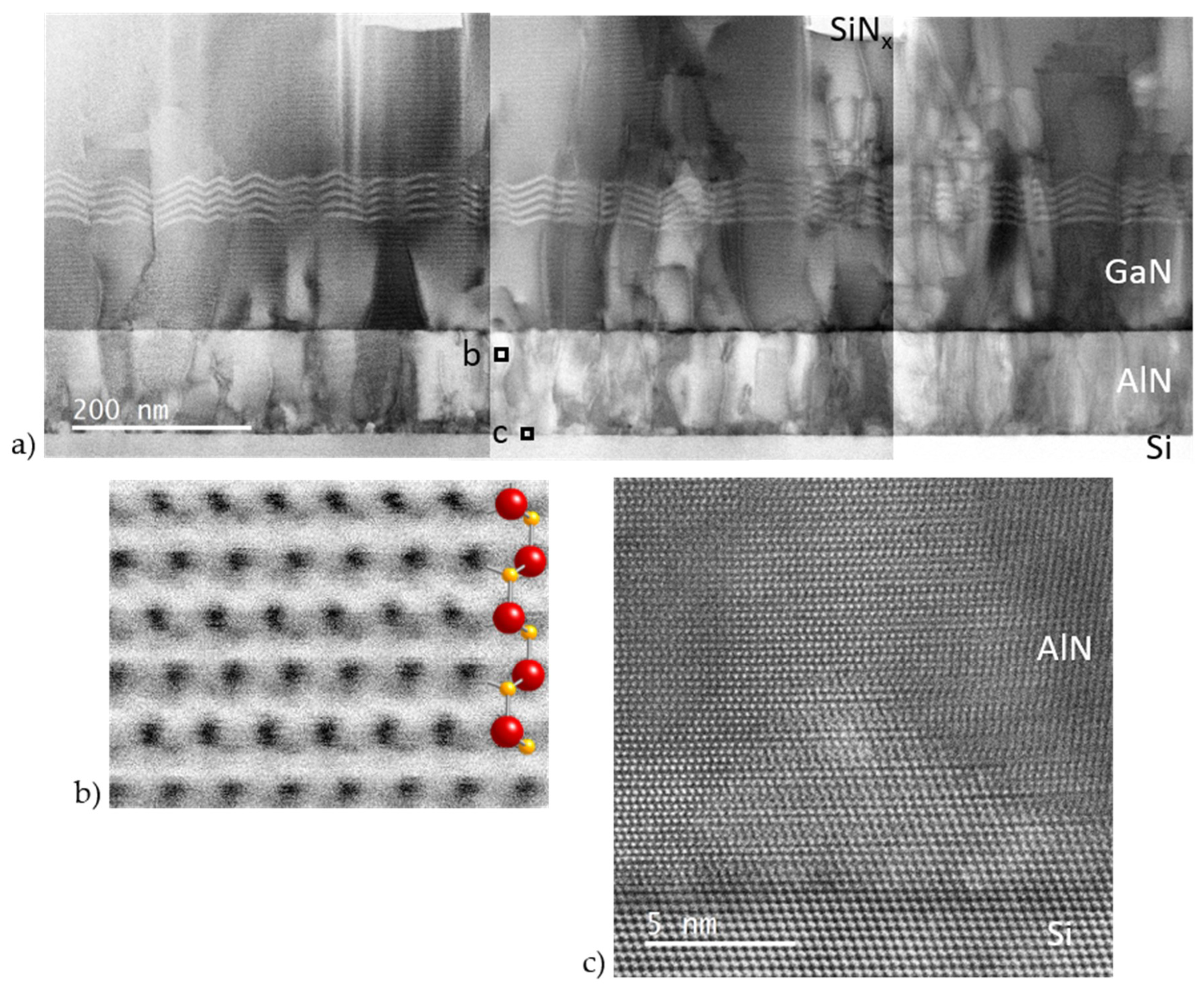Selective Area Growth and Structural Characterization of GaN Nanostructures on Si(111) Substrates
Abstract
:1. Introduction
2. Materials and Methods
2.1. Growth
2.2. Strain Analysis
2.3. Morphology Analysis
3. Results
4. Conclusions
Author Contributions
Funding
Conflicts of Interest
References
- Sanchez-Garcia, M.A.; Albert, S.; Bengoechea-Encabo, A.; Barbagini, F.; Calleja, E. Selective area growth of gan nanowires by plasma-assisted molecular beam epitaxy. In Wide Band Gap Semiconductor Nanowires for Optical Devices: Low-dimensionality Related Effects and Growth; Consonni, V., Feuillet, G., Eds.; Wiley: Somerset, NJ, USA, 2014; pp. 215–243. [Google Scholar]
- Kishino, K.; Ishizawa, S. Selective-area growth of GaN nanocolumns on Si(111) substrates for application to nanocolumn emitters with systematic analysis of dislocation filtering effect of nanocolumns. Nanotechnology 2015, 26, 225602. [Google Scholar] [CrossRef] [PubMed]
- Yamano, K.; Kishino, K.; Sekiguchi, H.; Oto, T.; Wakahara, A.; Kawakami, Y. Novel selective area growth (SAG) method for regularly arranged AlGaN nanocolumns using nanotemplates. J. Cryst. Growth 2015, 425, 316–321. [Google Scholar] [CrossRef]
- Albert, S.; Bengoechea-Encabo, A.; Sanchez-Garcia, M.A.; Kong, X.; Trampert, A.; Calleja, E. Selective area growth of In(Ga)N/GaN nanocolumns by molecular beam epitaxy on GaN-buffered Si(111): From ultraviolet to infrared emission. Nanotechnology 2013, 24, 175303. [Google Scholar] [CrossRef] [PubMed]
- Brubaker, M.D.; Duff, S.M.; Harvey, T.E.; Blanchard, P.T.; Roshko, A.; Sanders, A.W.; Sanford, N.A.; Bertness, K.A. Polarity-controlled GaN/AlN nucleation layers for selective-area growth of GaN nanowire arrays on Si(111) substrates by molecular beam epitaxy. Cryst. Growth Des. 2016, 16, 596–604. [Google Scholar] [CrossRef]
- Brubaker, M.D.; Roshko, A.; Blanchard, P.T.; Harvey, T.E.; Sanford, N.A.; Bertness, K.A. Spontaneous growth of GaN nanowire nuclei on N- and Al-polar AlN: A piezoresponse force microscopy study of crystallographic polarity. Mater. Sci. Semicond. Process. 2016, 55, 67–71. [Google Scholar] [CrossRef]
- Blanchard, P.; Brubaker, M.; Harvey, T.; Roshko, A.; Sanford, N.; Weber, J.; Bertness, K. Characterization of sub-monolayer contaminants at the regrowth interface in GaN nanowires grown by selective-area molecular beam epitaxy. Crystals 2018, 8, 178. [Google Scholar] [CrossRef]
- Cullity, B.D. Elements of X-ray Diffraction, 2nd ed.; Addison-Wesley Publishing: Reading, MA, USA, 1978. [Google Scholar]
- Darakchieva, V.; Paskova, T.; Paskov, P.P.; Monemar, B.; Ashkenov, N.; Schubert, M. Structural characteristics and lattice parameters of hydride vapor phase epitaxial GaN free-standing quasisubstrates. J. Appl. Phys. 2005, 97, 013517. [Google Scholar] [CrossRef]
- Yim, W.M.; Paff, R.J. Thermal expansion of aln, sapphire, and silicon. J. Appl. Phys. 1974, 45, 1456–1457. [Google Scholar] [CrossRef]
- Bourret, A.; Barski, A.; Rouviere, J.L.; Renaud, G.; Barbier, A. Growth of aluminum nitride on (111) silicon: Microstructure and interface structure. J. Appl. Phys. 1998, 83, 2003–2009. [Google Scholar] [CrossRef]
- Meng, W.J.; Sell, J.A.; Perry, T.A.; Rehn, L.E.; Baldo, P.M. Growth of aluminum nitride thin films on Si(111) and Si(001): Structural characteristics and development of intrinsic stresses. J. Appl. Phys. 1994, 75, 3446–3455. [Google Scholar] [CrossRef]
- Liu, R.; Ponce, F.A.; Dadgar, A.; Krost, A. Atomic arrangement at the AlN/Si (111) interface. Appl. Phys. Lett. 2003, 83, 860–862. [Google Scholar] [CrossRef]
- Schenk, H.P.D.; Kaiser, U.; Kipshidze, G.D.; Fissel, A.; Kraußlich, J.; Hobert, H.; Schulze, J.; Richter, W. Growth of atomically smooth AlN films with a 5:4 coincidence interface on Si(111) by MBE. Mater. Sci. Eng. B 1999, 59, 84–87. [Google Scholar] [CrossRef]
- Stevens, K.S.; Kinniburgh, M.; Schwartzman, A.F.; Ohtani, A.; Beresford, R. Demonstration of a silicon field-effect transistor using AlN as the gate dielectric. Appl. Phys. Lett. 1995, 66, 3179–3181. [Google Scholar] [CrossRef]
- Consonni, V.; Knelangen, M.; Geelhaar, L.; Trampert, A.; Riechert, H. Nucleation mechanisms of epitaxial GaN nanowires: Origin of their self-induced formation and initial radius. Phys. Rev. B 2010, 81, 085310. [Google Scholar] [CrossRef]
- Furtmayr, F.; Vielemeyer, M.; Stutzmann, M.; Arbiol, J.; Estradé, S.; Peirò, F.; Morante, J.R.; Eickhoff, M. Nucleation and growth of GaN nanorods on Si (111) surfaces by plasma-assisted molecular beam epitaxy—The influence of Si- and Mg-doping. J. Appl. Phys. 2008, 104, 034309. [Google Scholar] [CrossRef] [Green Version]
- Knelangen, M.; Consonni, V.; Trampert, A.; Riechert, H. In situ analysis of strain relaxation during catalyst-free nucleation and growth of GaN nanowires. Nanotechnology 2010, 21, 245705. [Google Scholar] [CrossRef] [PubMed]
- Landré, O.; Bougerol, C.; Renevier, H.; Daudin, B. Nucleation mechanism of GaN nanowires grown on (111) Si by molecular beam epitaxy. Nanotechnology 2009, 20, 415602. [Google Scholar] [CrossRef] [PubMed]
- Landré, O.; Fellmann, V.; Jaffrennou, P.; Bougerol, C.; Renevier, H.; Daudin, B. Growth mechanism of catalyst-free [0001] GaN and AlN nanowires on Si by molecular beam epitaxy. Phys. Status Solidi C 2010, 7, 2246–2248. [Google Scholar] [CrossRef]
- Ristić, J.; Calleja, E.; Fernández-Garrido, S.; Cerutti, L.; Trampert, A.; Jahn, U.; Ploog, K.H. On the mechanisms of spontaneous growth of III-nitride nanocolumns by plasma-assisted molecular beam epitaxy. J. Cryst. Growth 2008, 310, 4035–4045. [Google Scholar] [CrossRef] [Green Version]
- Gačević, Z.; Gomez Sanchez, D.; Calleja, E. Formation mechanisms of GaN nanowires grown by selective area growth homoepitaxy. Nano Lett. 2015, 15, 1117–1121. [Google Scholar] [CrossRef] [PubMed]
- De Yoreo, J.J. Principles of crystal nucleation and growth. Rev. Mineral. Geochem. 2003, 54, 57–93. [Google Scholar] [CrossRef]
- Flemings, M.C. Solidification Processing; McGraw-Hill: New York, NY, USA, 1974; p. 364. [Google Scholar]
- Zywietz, T.; Neugebauer, J.; Scheffler, M. Adatom diffusion at GaN (0001) and (0001) surfaces. Appl. Phys. Lett. 1998, 73, 487–489. [Google Scholar] [CrossRef]
- Auzelle, T.; Haas, B.; Minj, A.; Bougerol, C.; Rouvière, J.-L.; Cros, A.; Colchero, J.; Daudin, B. The influence of AlN buffer over the polarity and the nucleation of self-organized GaN nanowires. J. Appl. Phys. 2015, 117, 245303. [Google Scholar] [CrossRef]
- Roshko, A.; Brubaker, M.D.; Blanchard, M.D.; Bertness, K.A.; Harvey, T.E.; Geiss, R.H.; Levin, I. Comparison of convergent beam electron diffraction and annular bright field atomic imaging for GaN polarity determination. J. Mater. Res. 2016, 32, 936–946. [Google Scholar] [CrossRef]
- de la Mata, M.; Magen, C.; Gazquez, J.; Utama, M.I.; Heiss, M.; Lopatin, S.; Furtmayr, F.; Fernandez-Rojas, C.J.; Peng, B.; Morante, J.R.; et al. Polarity assignment in ZnTe, GaAs, ZnO, and GaN-AlN nanowires from direct dumbbell analysis. Nano Lett. 2012, 12, 2579–2586. [Google Scholar] [CrossRef] [PubMed]
- Chen, X.J.; Perillat-Merceroz, G.; Sam-Giao, D.; Durand, C.; Eymery, J. Homoepitaxial growth of catalyst-free GaN wires on N-polar substrates. Appl. Phys. Lett. 2010, 97, 151909. [Google Scholar] [CrossRef] [Green Version]
- Urban, A.; Malindretos, J.; Klein-Wiele, J.H.; Simon, P.; Rizzi, A. Ga-polar GaN nanocolumn arrays with semipolar faceted tips. New J. Phys. 2013, 15, 1–13. [Google Scholar] [CrossRef]
- Aseev, P.; Gačević, Ž.; Torres-Pardo, A.; González-Calbet, J.M.; Calleja, E. Improving optical performance of GaN nanowires grown by selective area growth homoepitaxy: Influence of substrate and nanowire dimensions. Appl. Phys. Lett. 2016, 108, 253109. [Google Scholar] [CrossRef]
- Gilmer, G.H.; Grabow, M.H. Models of thin film growth modes. J. Met. 1987, 39, 19–23. [Google Scholar] [CrossRef]
- Kong, X.; Li, H.; Albert, S.; Bengoechea-Encabo, A.; Sanchez-Garcia, M.A.; Calleja, E.; Draxl, C.; Trampert, A. Titanium induced polarity inversion in ordered (In,Ga)N/GaN nanocolumns. Nanotechnology 2016, 27, 065705. [Google Scholar] [CrossRef] [PubMed]
- Ruterana, P.; Sanchez, A.M.; Nouet, G. Nitride Semiconductors; Wiley VCH: Weinheim, Germany, 2003; p. 661. [Google Scholar]
- Sanchez, A.M.; Dimitrakopoulos, G.P.; P Ruterana, P. Mechanisms for the Formation of Inversion Domains in GaN; IOP Publishing Ltd.: Bristol, UK, 2004; Volume 180, p. 4. [Google Scholar]
- Coulon, P.-M.; Alloing, B.; Brändli, V.; Vennéguès, P.; Leroux, M.; Zúñiga-Pérez, J. Dislocation filtering and polarity in the selective area growth of GaN nanowires by continuous-flow metal organic vapor phase epitaxy. Appl. Phys. Express 2016, 9, 1–4. [Google Scholar] [CrossRef]
- Dreyer, C.E.; Janotti, A.; Van de Walle, C.G. Absolute surface energies of polar and nonpolar planes of GaN. Phys. Rev. B 2014, 89, 081305. [Google Scholar] [CrossRef]
- Jindal, V.; Shahedipour-Sandvik, F. Theoretical prediction of GaN nanostructure equilibrium and nonequilibrium shapes. J. Appl. Phys. 2009, 106, 083115. [Google Scholar] [CrossRef]
- Neugebauer, J. Ab initio analysis of surface structure and adatom kinetics of group-III nitrides. Phys. Status Solidi B 2001, 227, 93–114. [Google Scholar] [CrossRef]
- Northrup, J.E.; Neugebauer, J. Theory of GaN and surfaces. Phys. Rev. B 1996, 53, R10477. [Google Scholar]
- Trampert, A.; Kong, X.; Luna, E.; Grandal, J.; Jenichen, B. Microstructure of group III-N nanowires. In Wide Band Gap Semiconductor Nanowires for Optical Devices: Low-dimensionality Related Effects and Growth; Consonni, V., Feuillet, G., Eds.; Wiley: Somerset, NJ, USA, 2014; pp. 125–156. [Google Scholar]
- Consonni, V. Self-induced growth of GaN nanowires by plasma-assisted molecular beam epitaxy. In Wide Band Gap Semiconductor Nanowires for Optical Devices: Low-dimensionality Related Effects and Growth; Consonni, V., Feuillet, G., Eds.; Wiley: Somerset, NJ, USA, 2014; pp. 177–213. [Google Scholar]
- Shen, X.Q.; Ide, T.; Cho, S.H.; Shimizu, M.; Hara, S.; Okumura, H. Stability of N- and Ga-polarity GaN surfaces during the growth interruption studied by reflection high-energy electron diffraction. Appl. Phys. Lett. 2000, 77, 4013–4015. [Google Scholar] [CrossRef]
- Murray, J.L.; McAIister, A.J. The Al-Si (aluminum-silicon) system. Bull. Alloy Phase Diagr. 1994, 5, 74–84. [Google Scholar] [CrossRef]
- Adelmann, C.; Brault, J.; Mula, G.; Daudin, B.; Lymperakis, L.; Neugebauer, J. Gallium adsorption on (0001) GaN surfaces. Phys. Rev. B 2003, 67, 165419. [Google Scholar] [CrossRef]
- Neugebauer, J.; Zywietz, T.K.; Scheffler, M.; Northrup, J.E.; Chen, H.; Feenstra, R.M. Adatom kinetics on and below the surface: The existence of a new diffusion channel. Phys. Rev. Lett. 2003, 90, 056101. [Google Scholar] [CrossRef] [PubMed]
- Northrup, J.E.; Neugebauer, J.; Feenstra, R.M.; Smith, A.R. Structure of GaN(0001): The laterally contracted Ga bilayer model. Phys. Rev. B 2000, 61, 9932–9935. [Google Scholar] [CrossRef] [Green Version]
- Ruterana, P. Convergent beam electron diffraction investigation of inversion domains in GaN. J. Alloys Compd. 2005, 401, 199–204. [Google Scholar] [CrossRef]
- Daudin, B.; Rouvière, J.L.; Arley, M. Polarity determination of GaN films by ion channeling and convergent beam electron diffraction. Appl. Phys. Lett. 1996, 69, 2480–2482. [Google Scholar] [CrossRef]
- Daudin, B.; Rouvière, J.L.; Arley, M. The key role of polarity in the growth process of (0001) nitrides. Mater. Sci. Eng. B 1997, 43, 157–160. [Google Scholar] [CrossRef]
- Rouviere, J.L.; Weyher, J.L.; Seelmann-Eggebert, M.; Porowski, S. Polarity determination for GaN films grown on (0001) sapphire and high-pressure-grown GaN single crystals. Appl. Phys. Lett. 1998, 73, 668–670. [Google Scholar] [CrossRef]






| Sample 1 | Substrate/Buffer | AlN (nm) | GaN Buffer (nm) | SiNx (nm) | Buffer ao 2 (nm) | Δao mismatch (%) 3 |
|---|---|---|---|---|---|---|
| N-Al | Si(111)/AlN | 40 ± 5 | 0 | 74 | 0.3115 ± 0.0001 | 2.4 ± 0.2 |
| N-AlGa | Si(111)/AlN/GaN | 50 ± 5 | 45 ± 5 | 54 | 0.3195 ± 0.0005 | −0.18 ± 0.06 |
| N-AlGaSL-1 | Si(111)/AlN/GaN + SL | 20 ± 2 | 295 ± 15 | 25 | 0.3188 ± 0.0002 | 0.019 ± 0.002 |
| N-AlGaSL-2 | Si(111)/AlN/GaN + SL | 20 ± 2 | 305 ± 20 | 50 | 0.3189 ± 0.0001 | −0.006 ± 0.0004 |
| N-GaN | N-polar GaN | 0 | 0 | 50 | 0.3189 4 | 0 |
© 2018 by the authors. Licensee MDPI, Basel, Switzerland. This article is an open access article distributed under the terms and conditions of the Creative Commons Attribution (CC BY) license (http://creativecommons.org/licenses/by/4.0/).
Share and Cite
Roshko, A.; Brubaker, M.; Blanchard, P.; Harvey, T.; Bertness, K.A. Selective Area Growth and Structural Characterization of GaN Nanostructures on Si(111) Substrates. Crystals 2018, 8, 366. https://doi.org/10.3390/cryst8090366
Roshko A, Brubaker M, Blanchard P, Harvey T, Bertness KA. Selective Area Growth and Structural Characterization of GaN Nanostructures on Si(111) Substrates. Crystals. 2018; 8(9):366. https://doi.org/10.3390/cryst8090366
Chicago/Turabian StyleRoshko, Alexana, Matt Brubaker, Paul Blanchard, Todd Harvey, and Kris A. Bertness. 2018. "Selective Area Growth and Structural Characterization of GaN Nanostructures on Si(111) Substrates" Crystals 8, no. 9: 366. https://doi.org/10.3390/cryst8090366





